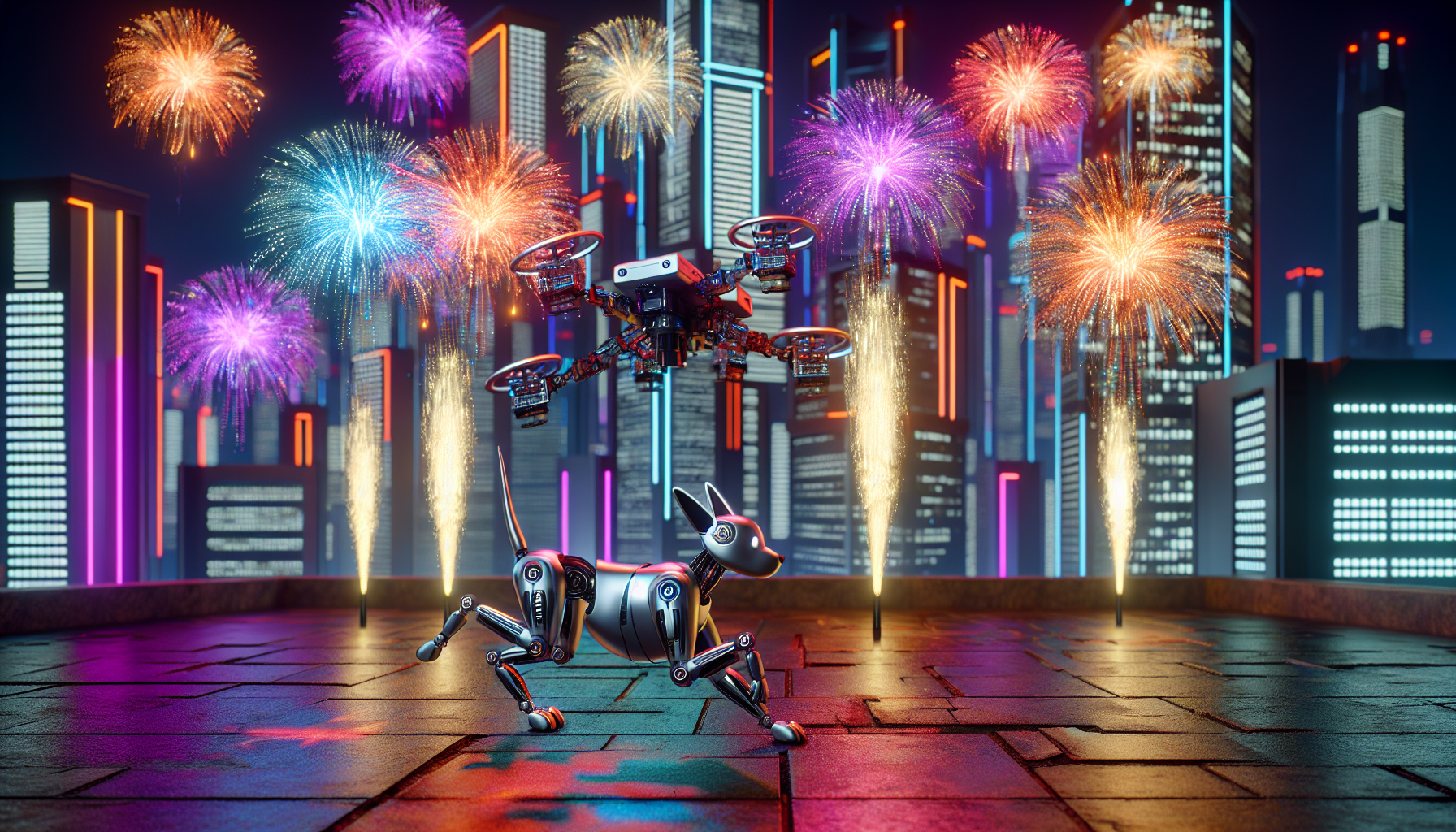- Empty cart.
- Continue Shopping
Robot Dog and Drone Battle with Fireworks in Viral Video – robotic warfare

robotic warfare –
Robot Dog and Drone Battle with Fireworks in Viral Video
In a spectacular showcase that resembles a scene from a sci-fi movie, a recent video of a robotic warfare skirmish involving a robot dog and a drone armed with fireworks has captivated audiences worldwide. This viral sensation hints at the evolving nature of modern technology and foreshadows the potential future of combat scenarios.
The Viral Phenomenon: Robot vs. Drone
As the video circulated across social media platforms, viewers were both entertained and intrigued by this unique battle. Amidst a backdrop reminiscent of futuristic battlegrounds, a robot dog and a drone were seen exchanging a storm of fireworks, lighting up the scene with a display that was as captivating as it was unsettling.
The video not only highlights the nimbleness and aggression with which these machines can operate but also hints at their possible applications in real-world situations. Here’s what makes this video intriguing:
- Intense Action: The explosive fireworks mirrored real-world projectiles, showcasing how drones and robotic units could potentially maneuver in a conflict zone.
- Sophisticated Technology: Both the robot dog and the drone exhibited advanced mobility and targeting capabilities.
- Entertainment Value: The striking visuals of fireworks, combined with the suspenseful chase, kept viewers glued to their screens.
The Rise of Robotic Warfare
While historically, warfare has been dominated by human soldiers and traditional machinery, the advent of robotic warfare signals a major shift. Here’s how robots and drones are gradually becoming pivotal to modern military strategies:
Key Elements Driving Robotic Warfare
- Analysis and Strategy: Robotics can analyze vast amounts of data rapidly, formulating strategic responses quicker than human counterparts.
- Precision and Efficiency: Machines can execute tasks with pinpoint accuracy, reducing collateral damage and improving mission success rates.
- Reduced Risk to Human Life: With robots undertaking dangerous tasks, risks to human soldiers are significantly minimized.
Advantages of Robotic Systems in Combat
The integration of robotic systems into modern warfare has brought about several advantages, including:
- Operational Cost Reduction: While the initial investment may be high, long-term operational costs are reduced due to increased efficiency and reduced human resource needs.
- Enhanced Capabilities: Robots can be equipped with diverse capabilities ranging from surveillance to combat, making them versatile within varying military contexts.
- Diverse Applications: Beyond direct combat, robotic systems can be used for reconnaissance, logistics, and search and rescue missions.
Implications for Civilian Technology
The viral video not only sheds light on potential military applications but also showcases how innovations in robotic warfare can trickle down to civilian uses. Here’s how:
- Search and Rescue: The mobility and adaptability of robots could significantly enhance the efficacy of disaster response teams.
- Exploration: Robots could be used for exploration in hazardous environments, such as underwater or in space, where human presence might be too risky.
- Security: Robotic systems can be deployed for surveillance purposes, increasing the efficiency of security in public and private sectors.
The Ethics and Challenges of Robotic Warfare
While the advancement of robotic systems offers numerous advantages, it also presents ethical concerns and operational challenges:
Concerns with Autonomous Systems
- Decision-Making: The delegation of life-and-death decisions to machines raises ethical questions about accountability.
- Target Recognition: Accurate identification of potential threats and non-combatants is critical to prevent unintended casualties.
- Data Security: With extensive reliance on data, ensuring the cybersecurity of these systems is paramount to prevent hacking and unauthorized manipulation.
Legal and Ethical Frameworks
As technology progresses, there is a pressing need to establish frameworks that govern the use of robots in both wartime and peacetime:
- Regulatory Guidelines: Formulating international agreements and treaties to manage the deployment and use of autonomous warfare systems.
- Training Protocols: Ensuring thorough and ongoing training for operators and developers of these systems.
- Impact Assessment: Conducting comprehensive studies to evaluate the long-term societal impacts of deploying robotic systems in various domains.
Future Perspectives on Robotic Warfare
The potential applications of robotic warfare are vast and varied, with continually evolving technology promising to redefine global security strategies:
Innovations on the Horizon
- AI-Driven Platforms: The integration of artificial intelligence can enable more intuitive decision-making processes and refined operational strategies.
- Biomimicry Designs: Adopting designs inspired by nature could enhance the mobility and efficiency of robotic systems.
- Advanced Communication Networks: Improving communication and coordination between various robotic units can lead to more cohesive military strategies.
Global Adoption and Integration
The growing acceptance and integration of robotic systems into national defense architectures is evident worldwide:
- Collaborative Defense Initiatives: Countries are forming alliances, sharing technological advancements to enhance mutual defense capabilities.
- Industry Investment: Increased investment in robotics by defense contractors and tech companies is accelerating the development and deployment of advanced systems.
- Cross-Disciplinary Research: Collaboration between engineers, scientists, and military experts is driving innovation in the realm of robotic warfare.
The Impact of Viral Videos on Public Perception
The viral nature of the robot dog and drone video has significant implications for public engagement with and understanding of robotic warfare:
- Increased Awareness: Such videos serve to educate the public on the realities and potentials of robotic systems in military and civilian life.
- Stimulating Dialogue: Discussions and debates regarding the ethical and practical aspects of robotic warfare are prompted by such striking visual content.
- Motivating Innovation: Viral content inspires further research and development, encouraging technologists to push the boundaries of current capabilities.
Conclusion
The viral video’s spectacle of a robot dog and drone illuminated by fireworks is emblematic of the rapid advancement and growing complexity of robotic warfare. As society paves its path through the integration of robots in daily operations—whether military or civilian—continued dialogue, ethical vigilance, and technological refinement are paramount. The future of combat and security is undeniably intertwined with the capabilities and limitations of robotic technology, suggesting that what was once science fiction is now shaping up to be a facet of our ever-evolving reality.
Pet Accessory Extravaganza: Unbelievable Amazon Deals!
Watch funny and cute dog videos!
Disclaimer: This article was generated with the assistance of AI technology. All images featured on this website are either sourced from free-to-use platforms, created by us, generated with the assistance of AI technology or used with permission. If you believe an image on this site violates copyright or your rights, please contact us, and we will address the issue promptly.

















